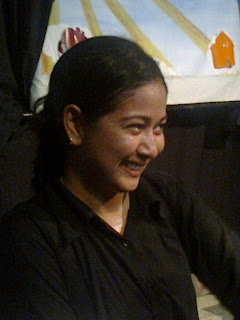A Bird's Eye View
The bird’s eye view, literally, of the story
of a war is an interesting concept, and that’s how
innovative theatre can get. On the 30th of June, 2012, TRAM theatre
presented a non-verbal object theatre, ‘A bird’s eye view’, at the Studio Safdar
in Delhi.
Studio
Safdar is tucked away in a corner of New Ranjit Nagar near Satyam Cineplex,
Patel Nagar, Delhi. It is founded by the theatre group Jana Natya Morcha. The
place has a small theatre with a very informal setting, a cafeteria and a book
shop. The ambience makes you feel the informal creativity that the place is
full of. Chennai-based artist Praveen has painted murals on the exterior of the
building.
TRAM
theatre was founded in 2011 in Mumbai with the object of practicing and
propagating object theatre. The story in the play is told with the help of
objects, drawings/paintings and an actor who handles them. This form of theatre
is a sub-genre of puppetry; it lifts everyday objects and lends them a
personality.
Choiti Ghosh
Choiti
Ghosh, an object theatre practitioner, actor and puppeteer, was the director and
actor of the evening’s play. The performance began with a pair of boots walking
and clicking, or in fact, being manipulated by Choiti. The boots are the villains
of the show, the power hungry makers warmongers. Then begins the story of ‘Milu’, a
carrier pigeon. The scene is a bird-house and a tree. Choiti with the hat is
the trainer and without it, the pigeon. In the bird-house, the egg is
incubated, the fledgling is fed milk and worms and finally, ‘Milu’ the
pigeon emerges from his house. The tree also grows bigger. ‘Milu’ is a toy
pigeon and Choiti does all the cooing. Next is the training of ‘Milu’. Again,
Choiti with the hat is the trainer, and without it, ‘Milu’. The trainer tries
his utmost to make ‘Milu’ fly, but the pigeon is quite reluctant. Choiti keeps
shouting – “Milu, training!”, but the pigeon does not fly. So, Choiti as the
trainer puts the bird-house amongst the audience and ‘Milu’ readily flies,
cooing innocently. The first message that ‘Milu’ carries is ‘Good boy, Milu’. Then ‘Milu’ makes friends – two plastic frogs and a toy mouse. His mate is
another toy pigeon. Milu wears a red bow and his mate wears a veil and they get
married. The bird-house now has a home-sweet-home banner. But this happiness
does not last. All is lost in a storm and ‘Milu’ is taken captive.
The scene
changes and Choiti makes the two wicked boots kick and trample a plastic globe,
representing the earth. War breaks out. To show the war, Choiti spread sand on
a plastic sheet and placed GI Joe figurines on it to depict soldiers. The two
big boots are the commanders of the wars. Gun shots were fired from toy guns.
Darts were missiles and glowing balls were bombs. The soldiers keep dying in
the firing. One of the boots takes out a rifle and shoots the other, who then
lies injured. The injured boot then sends out a message for “help”. Now it’s
the job of ‘Milu’ to carry the message around his neck. ‘Milu’ relentlessly
flies to convey the message. A screen in the background shows the night and day
that Milu is flying through. The screens were made by two ten-year-old kids.
Along the way, Milu is shot at and falls almost dead. An eagle is hovering,
waiting for him to die. Milu has visions of his wife and friends. Choiti shows
his pain and struggle to keep alive. Finally, with a lot of will power and
effort, Milu flies off again on his mission.
Choiti next
showed a village set on fire by smaller shoes which are the subjects of the
bigger boots. Milu bravely douses the fire and moves on. The next scene is that
of a pond of water which is shown by a glass bowl filled with blue water with
toy birds and trees around it. A thirsty Milu comes to drink at the pond but
finds it contaminated with guns and dead soldiers. In the midst of the war of
the boots, Milu flies towards the mountains shown by a change of the screen. He
is very cold and Choiti makes him wear a woollen scarf. He then reaches his home again and in the clouds, he is dreaming of his friends and mate, again shown
in the background screen. But once there, he finds his house broken and the tree barren.
Finally, Choiti becomes an army man and awards Milu with a medal, a trophy and
the honour of being given the title of 'Agent Milu'. She spoke in some
incomprehensible gibberish which sounded hilarious, but conveyed the meanings beautifully. Milu, meanwhile, cannot
comprehend the situation and keeps looking around, cooing to the audience,
again enacted by Choiti. The irony of Milu’s life is apparent, since he does not
fathom what he has gained.
The special
effects, props, sound effects and lighting were excellent. Choiti did a
wonderful job of manipulating the objects and at the same time, enacting the
characters to convey a very touching story.



Comments
Post a Comment